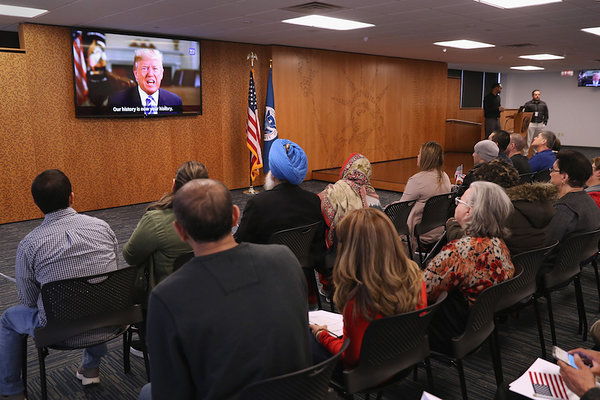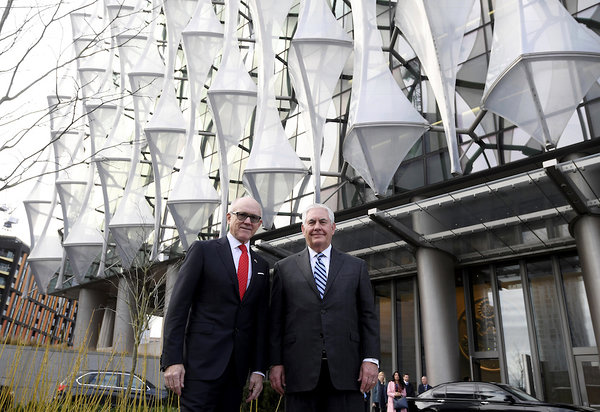One of the self-adopted themes of Trump’s presidency was ‘America first’. In accordance with this theme, the first year of Trump’s presidency has focused on domestic issues: health care, immigration, and tax reform. Trump’s domestic agenda has had rocky moments, including judicial and legislative defeats to immigration and health care reform. Despite the setbacks, the Republican-controlled Congress passed sweeping tax reforms, dropping the corporate tax rate from 35% to 21%. Trump’s priority will likely remain on his domestic agenda at least through 2019. As most presidents come to realize, advancing one’s domestic agenda is significantly harder than pursuing an international agenda due to the system of checks and balances, including judicial and Congressional oversight.
President Donald Trump addresses new American citizens on a taped video shown at a naturalization ceremony on January 22, 2018 in Newark, New Jersey. Immigrants from 32 different countries became citizens at the event held by U.S. Citizenship and Immigration Services (USCIS) in Newark. AFP/Scanpix
Continuity in US foreign policy
‘America first’ is also a foreign policy strategy. Though Trump’s focus has been his domestic agenda, he has still been active internationally bringing both change and continuity to US foreign policy. Relations with Russia have remained frosty. A US president has more flexibility in determining foreign policy, but it is not completely without constraints. Relations with Russia have remained frosty largely due to pressure from Congress as well as investigations into Russia’s election meddling and connections between Trump’s campaign and Russia. Trump’s decision to launch missile strikes on a Syrian air base that was used in a chemical weapons strike certainly contrasts with Obama’s decision to pursue diplomacy after Assad crossed the same ‘red line’. A closer inspection reveals more continuity than change in US policy towards Syria with the US largely staying on the sidelines. Trump’s decision to increase troop levels in Afghanistan also places his policy within the expectations of the foreign policy establishment.
Tensions with Iran and North Korea also are nothing new to US policy makers. Though Trump is taking a harder line towards Iran than Obama, dynamics in the Middle East would have prevented any real thaw in US-Iranian relations. Trump’s decision to recognize Jerusalem as Israel’s capital and to move the US embassy there has long been a Republican priority. Mitt Romney campaigned on the same promise in 2012. In regard to North Korea, the rhetoric has changed, especially when considering Trump’s Twitter activity. At the policy level, the US is largely attempting to gather international support for stricter sanctions. This is a process that has been going on for decades. Overall, there has been a surprising amount of continuity in Trump’s foreign policy.
Trump’s foreign policy and the changing world order
There have been important differences that should be noted due to their impact on the changing world order. One of Trump’s first foreign policy decisions was to withdraw from the Trans-Pacific Partnership (TPP) negotiations. Although the remaining nations have not abandoned TPP negotiations, Trump’s withdrawal creates a void in regional economic leadership. Trump has talked tough on trade and it remains to be seen what, if any, changes will happen to the North American Free Trade Agreement (NAFTA). Perhaps the most groundbreaking foreign policy decision Trump has made was to pull out of the Paris climate accords. This decision was met by international criticism, but was done largely for domestic reasons.
In the wake of Trump’s ‘America first’ foreign policy, and the reduction of US leadership, China has made steps toward filling the void. China is forging ahead as a leader in environmental cooperation and green energy. It is also pushing its own economic agenda in the Asia-Pacific region, including the One Belt One Road initiative and its own free trade agreement, the Regional Comprehensive Economic Partnership (RCEP). China is developing a web of economic interdependencies that place the country at the economic center of the region. Trump’s aversion towards multilateral institutions and treaties is accelerating the pace of change in the world order.
Trump and transatlantic relations
While Trump’s policies have accelerated change on the global level, in Asia and the Middle East in particular, transatlantic relations have remained surprisingly stable. As was mentioned, Trump withdrew from the TPP but it is important to note that he did not withdraw from the Transatlantic Trade and Investment Partnership (TTIP) negotiations. There have been tensions in German-US relations with Germany, notably downgrading the United States from “friend” to “most important partner” in Angela Merkel’s party’s electoral program. Though concerning, this tension is not any worse than the tensions when the US was caught spying on Merkel’s telephone conversations when Obama was president in 2013. Minor bumps aside, Trump’s commitment to transatlantic relations has been surprising.
It can be said that NATO is the glue that holds transatlantic relations together. As a candidate, Trump carried a populist tune about NATO being obsolete and focusing on European member state’s low financial commitment to defense. This combined with the potential of rapprochement with Russia concerned European countries. No one was expecting a Molotov-Ribbentrop Pact 2.0 but there was concern that the high point of NATO solidarity was over. One year on, that does not appear to be the case. President Trump and his administration have supported NATO’s Article 5 in word and deed. The United States has continued to support NATO’s enhanced forward presence and recently pledged $100 million in military aid to bolster the Baltic states’ national defense. For now, NATO seems to be the exception to how Trump sees multilateral institutions.
Behind Trump’s foreign policy of continuity in transatlantic relations, we should note the actors that have also had a role in maintaining relations. Baltic leaders in particular, have had extraordinary contact with high-ranking US leaders in Trump’s administration as well as from Congress. Visits have occurred both in the US as well as in the Baltics.
One down, three to go
With one year down, President Trump still has three years left. That is plenty of time for doomsday scenarios to occur. On the other hand, inexperienced presidents often improve over time. President George W. Bush was much better in his second term once he shuffled his foreign policy team. Trump is a political outsider and setting up his team has been rocky. He has already replaced his national security advisor (Michael Flynn), chief of staff (Reince Priebus), and press secretary (Sean Spicer). Reports say that Rex Tillerson will be replaced as secretary of state sooner rather than later. The State Department’s will likely remain in a diminished role even under a new top diplomat. Trump will likely continue to lean on the military. How his foreign policy team comes together will be important in determining his success over the next three years.
U.S. Secretary of State Rex Tillerson, right, and Woody Johnson, U.S. ambassador to Britain stand outside the new U.S. embassy in London, Monday Jan. 22, 2018. Secretary of State Rex Tillerson has become the highest-ranking U.S. official to visit the new American embassy in London, a building that President Donald Trump derided for its cost and location. AP/Scanpix
With the threat of ISIS fading, Trump’s priorities will likely remain trade and immigration. It appears that Trump has not decided exactly what he will try to do with the future of NAFTA. Trump’s ambition to build a border wall and hardline immigration policies mean that relations with Mexico and other Latin American countries will be worth following.
Lastly, global events will also dictate Trump’s agenda and his ability to succeed. A nuclear North Korea will likely remain the dominant threat to US security for the next three years. The likelihood of an Iranian-style deal will be more difficult with the Pyongyang regime. At the same time, military options are not likely, either. Key US allies such as South Korea and Japan are less willing to support such measures which make military action difficult for the US. This means that high-stakes tensions and bluster will likely continue for the foreseeable future.
Lastly, global events will also dictate Trump’s agenda and his ability to succeed. A nuclear North Korea will likely remain the dominant threat to US security for the next three years. The likelihood of an Iranian-style deal will be more difficult with the Pyongyang regime. At the same time, military options are not likely, either. Key US allies such as South Korea and Japan are less willing to support such measures which make military action difficult for the US. This means that high-stakes tensions and bluster will likely continue for the foreseeable future.
For transatlantic relations, more continuity will likely continue and relations should be able to weather the storm of Trump’s blustery tweets. However, European leaders will need to proceed with caution. The top priorities for the Trump administration will remain outside of Europe and Trump will likely retain his transactional temperament. A transactional, disinterested United States will not be as valuable as a strategic partner as the United States of the past.
Trump’s first year as president has been one filled with headline-grabbing news. A closer look at policy revealed more continuity and fewer gaffes than were expected. Hopefully Trump can beat expectations in the next three years as well. The world order will continue to change, but with luck, the world will still be turning.
Matthew Crandall is an Associate Professor of International Relations at the Tallinn University |








